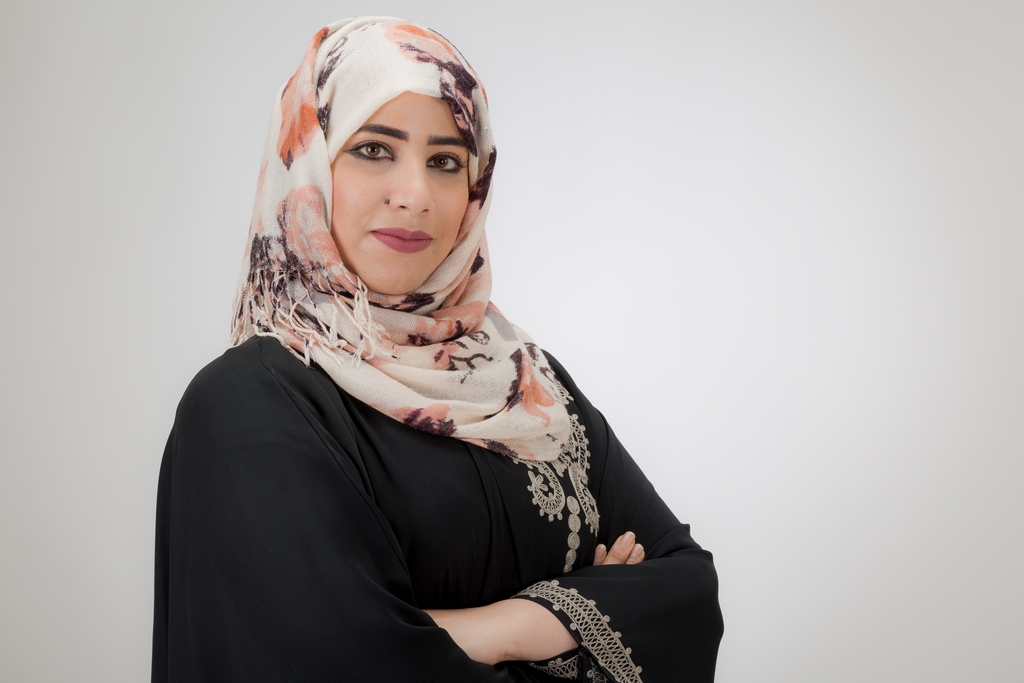
Thuria Abdullah Al Rahbi’s love of painting came as a gift. Right from early childhood she evolved her ideas of drawing and her art too moved forth with her life. Having conducted exhibitions at school level, she later on joined the Omani Society for Fine Arts, as an affiliate in the assembly participating in workshops and technical sessions and art exhibitions.
Thuria’s abstract style embodies many layers which are persistent in the bold lines of her works, reflecting the heritage that the beautiful Sultanate endows in abundance.
**media[370125]**
For long Thuria had been working on the idea of establishing an Omani exhibition abroad, and finally her dream saw the light of the day, in Paris. On March 23, her creations highlighting the beauty of the Omani art and way of life were showcased in the exhibition titled “Bidaa Al Ward” (Creativity of Roses).
The exhibition reflected the development and originality of Omani fashion through the really unique designs of fashion designer Fatima Al Jahwari. Another attraction at the exhibition was the plastic paintings inspired from the classic 1944 song Bida Al Ward inspired by the poetry of famous Hilmi Hakim, and sung by the Egyptian singing sensation of yesteryears Asmahan. Composed by Farid Al Atrash, the song is a beautiful narration of the life of roses.
The paintings by the 26-year-old Thuria, integrate the Omani authentic costumes from all regions of the Sultanate which retain the identity and authenticity of Omani aesthetic values.
The exhibition also included the works of nine other Omani artists and craftsmen highlighting the Omani traditional craft industry, a legacy passed on from generation to generation.
This festival is particularly important in terms of its objectives of multicultural exchange facilitating exchange of ideas between artists and creative individuals, and highlighting rich Omani fashion and handicrafts on international platform through contemporary art.
**media[370124]**
Aims of Bidaa Al Ward exhibition:
1. To revive the popular heritage of Oman and maintain the technical characteristics and show the treasures, as well as highlight its importance through presentation of paintings linked to Omani costumes, crafts, and traditional handicrafts.
2. To define the cultural and social heritage of Oman and developments in the Omani heritage, by making modern art blend with the past.
3. Showcasing the Sultanate abroad through cultural events of art mixed with music and Omani fashion, and to promote Oman as a tourist destination.
4. To strengthen the link and integration between the fields of contemporary music and visual art and fashion.
5. Open trade prospects between the Omani pioneers and their products and the new areas in France.
—[email protected]
The Exhibition Sections
Section 1: Musandam
Musandam is located in the far north of the Sultanate, and is characterised by its strategic location. In the exhibition, Musandam represents the gateway to the world of art and fashion, accompanied by song Bidaa Al Ward which is the theme of the exhibition.
Section 2: Al Batinah North
Al Batinah occupies Northern regions of the Sultanate, through which we enter into the world of roses, starting with seed collection. This section recognises the costumes of these distinguished regions expressing the seeds.
Section 3: Al Batinah South
This region represents the rose cultivation and is depicted by a ploughing vehicle and is embodied in five paintings.
Section 4: Buraimi
Buraimi is located in the northwest corner of the Sultanate. Since water is the lifeblood of all living organisms, pot water irrigation is embodied in five paintings.
Section 5: Muscat
Roses draw its life from leaves as a basic constituent in the growth process. Muscat is the lifeblood of the Sultanate and is the capital of Oman. The paintings are inspired by this brilliant idea of rose leaves to highlight the costumes and bright colours.
Section 6: North Al Sharqiyah
This region has the mix of three environments, each with its own distinctive flavour in Al Sharqiyah, where the buds emerge from the stalk of the plant, including the Al Sharqiyah
costumes in three paintings.
Section 7: South Al Sharqiyah
The south of Al Sharqiyah is part of the north and the roses get shading on distinctive colours. Red, which derives passion through the aesthetics of the costumes, is depicted in six paintings.
Section 8: Al Dakhiliyah
This region unique with its distinguished nature has the most popular cities which are considered as centres of culture and science in ancient Oman. Roses for the exhibition here take yellow colour expressing jealousy, characterised by this region’s costume in six paintings.
Section 9: Al Dhahira
Al Dhahira region is still home to the civilisation of the Omani heritage and a bridge for trade caravans and a commercial outlet to the world outside. This region represented by the white roses, the colour of chastity and love, is characterised by the region’s costume in six paintings.
Section 10: Al Wusta The region mediates the Sultanate; it separates the north and south. This region is the beating heart of Oman and is characterised by its costumes in five paintings.
Section 11: Dhofar
Dhofar is the land of frankincense and is rich in beauty and charming natural wonders, which differentiates the Sultanate from the rest of the GCC countries, and the exhibition concludes the tour with Dhofar in 45 paintings.